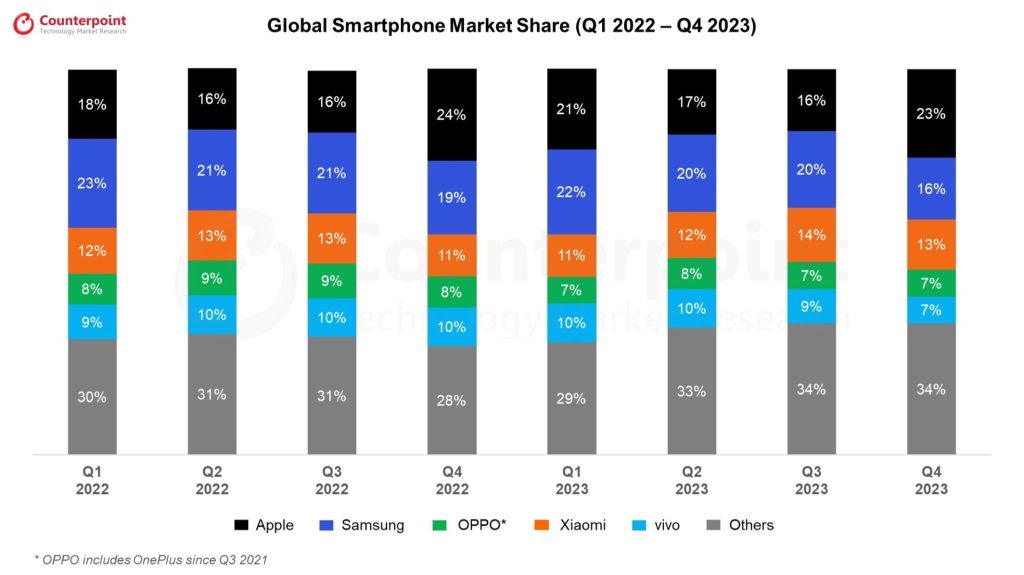Falling behind Magnificent Seven, Apple (NASDAQ:AAPL)'s bottom line is hindered. Will iPhone 16 sales and AI rally the company?
Apple stock is down -8.3% year-to-date, trending the opposite to its Magnificent Seven group, led by Meta Platforms (NASDAQ:META) and Nvidia (NASDAQ:NVDA). While the latter two have double-digit returns for the same period, AAPL shares took a hit at the beginning of the year.
Barclays analyst Tim Long pulled the first punch in January by downgrading AAPL to underweight (sell) from equal weight (neutral). Long reasoned that Apple’s iPhone 15 sales have underperformed, which should also play out for the iPhone 16 smartphone series.
At that time, Long placed the AAPL performance ceiling at 10% for the year. However, as the S&P 500 (SPX) turns 7.26% to Apple’s -8.3% year-to-date, should investors consider AAPL stock as a buying on the weakness opportunity?
Which fundamental hurdles does Apple face moving forward?
Tough China Competition and Market Shrinkage
In February’s earnings report for Q1 FY24, Apple reported $119.57 billion in total net sales. This was only a 2% improvement compared to the year-ago quarter. iPhone sales made up 58% of Apple’s total sales, at $69.7 billion. This is problematic because the company doesn’t have a highly entrenched global market share.
Apple’s iPhone unit shipments globally comprised 24.7% of the market share in Q4 ‘23. At the same time, China’s cheaper phones with similar features have been gaining ground from Huawei and Xiaomi. According to Counterpoint’s latest research, iPhone sales in China dropped 24% year-over-year in the first six weeks of 2024.
Unsurprisingly, Apple’s revenue forecast went $6 billion below Wall Street consensus. Additionally, Apple is not keeping up with the latest trends, such as foldable phones.
“In China, Apple is facing more competitive challenges not only because of Huawei but also because of foldables, which is a very popular and fast-growing segment in China – and as we all know, Apple does not have a foldable device – yet,”
International Data Corporation (IDC) analyst Nabila Popal
While Apple’s market share in China took the top spot in January at 17.3%, per IDC data, Apple iPhone shipments dropped 2.2% year-over-year, just as the overall smartphone market in China contracted by 7%. At the same time, Huawei significantly increased its market share from 9.4% to 16.5%, now closely in Apple’s shadow.
Samsung and Xiaomi Pursuing Apple’s Market Segments
Globally, Apple displaced Samsung at the top spot in Q4 2023, while Samsung remains the world’s top smartphone supplier annually, per Counterpoint Research. What is telling is the shift in market dynamics.
Chinese OEM Xiaomi expanded the most to cater to the mid-tier segment, having grown by 23% year-over-year in Q4 2023.

Image credit: Counterpoint
Apple’s brand loyalty and familiarity effectively prevent further shrinkage against cheaper smartphones in both premium and mid-tier segments. From this large base, AAPL stock could rally following an upgrade cycle to iPhone 16.
iPhone 16 Sales Yet to Follow Through?
This Tuesday, analysts at Wedbush Securities consulting firm acknowledged negative trends coming from China. Ming-Chi Kuo of TF International Securities had previously forecasted that Apple faces a 15% year-over-year decline in iPhone shipments, making the company as the hardest hit among competitors.
“iPhone 15 series and new iPhone 16 series shipments will decline by 10–15% YoY in 1H24 and 2H24, respectively (compared to iPhone 14 series shipments in 1H23 and iPhone 15 series shipments in 2H23, respectively).”
TF analyst Ming-Chi Kuo
However, Wedbush analysts view this as a transient phase in which iPhone estimates for 2024 remain hittable. Specifically, the upgrade cycle to iPhone 16 should result in over 270 million units worth of solid demand.
Wedbush analysts also noted Apple’s strong services growth. For the three months ending December 2023, this segment grew by 11.3% to $23.1 billion compared to a year ago quarter. Although Apple scrapped its take on EVs, inducing negative market sentiment, it also bears noting that the company has long-term plans for generative AI.
During February’s quarterly earnings call, Apple CEO Tim Cook said this enrichment feature will come online sometime “later this year”. While heavily relying on its generous share buyback program, AAPL stock still has optimistic long-term price targets.
What Is the AAPL Price Target?
Twelve months ahead, based on 30 analyst inputs pulled by Nasdaq, the average AAPL price target is $204.58 vs the current $170. The high estimate is $250, while the low forecast is $158 per share. Over one year, AAPL stock gained only 11% value.
This is in stark contrast to blue-chip favorites. NVDA gained 262% for the same period while META gained 166% value. Other Magnificent Seven companies are all in mid-to-high double-digit gains led by Amazon (NASDAQ:AMZN) (+86%). The only odd of the bunch is still Tesla with -6.5% loss of value, as EVs continue to fail to reach affordability threshold.
Neither the author, Tim Fries, nor this website, The Tokenist, provide financial advice. Please consult our website policy prior to making financial decisions.
***
This article was originally published on The Tokenist. Check out The Tokenist’s free newsletter, Five Minute Finance, for weekly analysis of the biggest trends in finance and technology.
